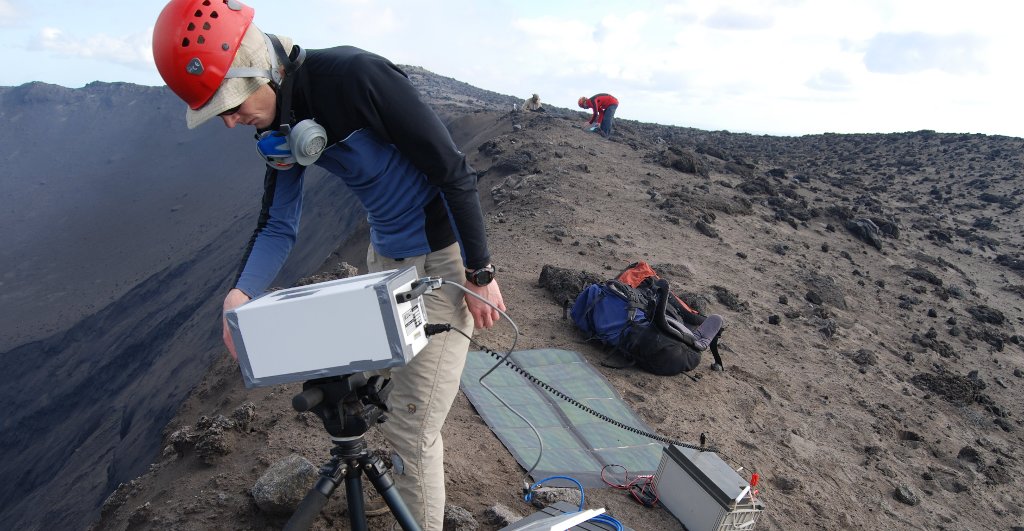A Fresh Look Inside Mount St. Helens
Volcanoes are notoriously hard to study. All the action takes place deep inside, at enormous temperatures. So geophysicists make models, using what they know to develop theories about what they don’t know.
Research led by Gregory P. Waite, an assistant professor of geophysics at Michigan Technological University, has produced a new seismic model for figuring out what’s going on inside Mount St. Helens, North America’s most active volcano. Waite hopes his research into the causes of the earthquakes that accompany the eruption of a volcano will help scientists better assess the hazard of a violent explosion at Mount St. Helens and similar volcanoes.
Waite and co-authors Bernard A. Chouet and Phillip B. Dawson published their findings on February 19, 2008, in the Journal of Geophysical Research. Waite’s research was conducted during a Mendenhall Postdoctoral Fellowship with the U.S. Geological Survey (USGS).
Volcanoes don’t always erupt suddenly and violently. The most recent eruption of Mount St Helens, for example, began in October 2004 and is still going on. It’s what Waite and other volcanologists call a passive eruption, with thick and sticky lava squeezing slowly out of the ground like toothpaste from a tube.
When a volcano such as Mount St Helens erupts, it can cause a series of shallow, repetitive earthquakes at intervals so regular that they’ve been called “drumbeat earthquakes.” Until now, scientists generally believed that these earthquakes were caused by the jerky movements of a solid plug of molten rock traveling up from the volcano’s core, a process known as the stick-slip model.
Modeling of seismic data collected by Waite and colleagues dispute that explanation. “The regularity and similarity of the shallow earthquakes seem consistent with a stick-slip model,” said Waite. Broadband measurements indicated that the energy is concentrated in a short bandwidth—between .5 and 2 Hz—and the earthquakes have nearly identical wave forms. Interestingly, the first motions observed at all of the seismic stations were the same.
“But this is not typical of a stick-slip event,” Waite said. “Rather, it suggests a source with a net volume change, such as a resonating fluid-filled crack.”
The fluid in the crack most likely is steam, derived from the magma and combined with water vaporized by the heat of the molten rock. A continuous supply of heat and fluid keeps the crack pressurized and the “drumbeats” beating, Waite explained.
“The pressurized crack in our model is filled with steam that could conceivably drive a small explosive eruption if the pattern (of earthquakes) we observe is disturbed,” he noted. Mount St. Helens erupted violently in 1980, losing nearly 1,000 feet of its cone-shaped top.
“The cause of Mount St. Helens earthquakes during the 2004-2008 eruption has been a matter of great debate,” said Seth Moran, the principal USGS seismologist monitoring the current eruption. “Greg collected a fantastic dataset with temporary seismometers and used highly sophisticated modeling techniques to produce a robust and intriguing model for the process responsible for those earthquakes. His model is somewhat different from the hypothesis that many other Mount St. Helens researchers have been using,” the seismologist went on to say, “and we are adjusting our understanding of the mechanics underlying the current eruption to incorporate his results.”
Waite’s co-author, Chouet, who also works for the USGS, proposed a similar seismological model for volcanoes in Hawaii, where the lava is much more fluid and flows more easily. This is the first time the model has been applied to volcanoes like Mount St. Helens, with slow-flowing, sticky lava.
Michigan Technological University is an R1 public research university founded in 1885 in Houghton, and is home to nearly 7,500 students from more than 60 countries around the world. Consistently ranked among the best universities in the country for return on investment, Michigan's flagship technological university offers more than 185 undergraduate and graduate degree programs in science and technology, engineering, computing, forestry, business, health professions, humanities, mathematics, social sciences, and the arts. The rural campus is situated just miles from Lake Superior in Michigan's Upper Peninsula, offering year-round opportunities for outdoor adventure.




Comments